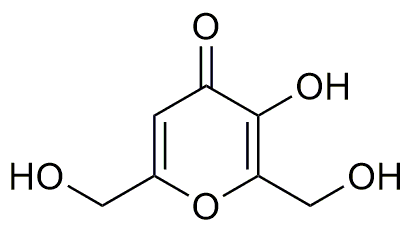3-Hydroxy-2,6-bis(hydroxymethyl)-4-pyrone is widely utilized in research focused on:
- Food Industry: This compound acts as a natural flavoring agent and antioxidant, enhancing the taste and shelf-life of various food products.
- Pharmaceuticals: It is explored for its potential therapeutic properties, including anti-inflammatory and antioxidant effects, making it valuable in drug formulation.
- Cosmetics: The compound is used in skincare products for its moisturizing and skin-repairing properties, appealing to consumers seeking natural ingredients.
- Agriculture: It serves as a natural pesticide, helping to protect crops from pests while being less harmful to the environment compared to synthetic alternatives.
- Biotechnology: Researchers utilize it in various biochemical assays and studies due to its unique chemical structure, which can interact with biological systems effectively.
General Information
Properties
Safety and Regulations
Applications
3-Hydroxy-2,6-bis(hydroxymethyl)-4-pyrone is widely utilized in research focused on:
- Food Industry: This compound acts as a natural flavoring agent and antioxidant, enhancing the taste and shelf-life of various food products.
- Pharmaceuticals: It is explored for its potential therapeutic properties, including anti-inflammatory and antioxidant effects, making it valuable in drug formulation.
- Cosmetics: The compound is used in skincare products for its moisturizing and skin-repairing properties, appealing to consumers seeking natural ingredients.
- Agriculture: It serves as a natural pesticide, helping to protect crops from pests while being less harmful to the environment compared to synthetic alternatives.
- Biotechnology: Researchers utilize it in various biochemical assays and studies due to its unique chemical structure, which can interact with biological systems effectively.
Documents
Safety Data Sheets (SDS)
The SDS provides comprehensive safety information on handling, storage, and disposal of the product.
Product Specification (PS)
The PS provides a comprehensive breakdown of the product’s properties, including chemical composition, physical state, purity, and storage requirements. It also details acceptable quality ranges and the product's intended applications.
Certificates of Analysis (COA)
Search for Certificates of Analysis (COA) by entering the products Lot Number. Lot and Batch Numbers can be found on a product’s label following the words ‘Lot’ or ‘Batch’.
*Catalog Number
*Lot Number
Certificates Of Origin (COO)
This COO confirms the country where the product was manufactured, and also details the materials and components used in it and whether it is derived from natural, synthetic, or other specific sources. This certificate may be required for customs, trade, and regulatory compliance.
*Catalog Number
*Lot Number
Safety Data Sheets (SDS)
The SDS provides comprehensive safety information on handling, storage, and disposal of the product.
DownloadProduct Specification (PS)
The PS provides a comprehensive breakdown of the product’s properties, including chemical composition, physical state, purity, and storage requirements. It also details acceptable quality ranges and the product's intended applications.
DownloadCertificates of Analysis (COA)
Search for Certificates of Analysis (COA) by entering the products Lot Number. Lot and Batch Numbers can be found on a product’s label following the words ‘Lot’ or ‘Batch’.
*Catalog Number
*Lot Number
Certificates Of Origin (COO)
This COO confirms the country where the product was manufactured, and also details the materials and components used in it and whether it is derived from natural, synthetic, or other specific sources. This certificate may be required for customs, trade, and regulatory compliance.


